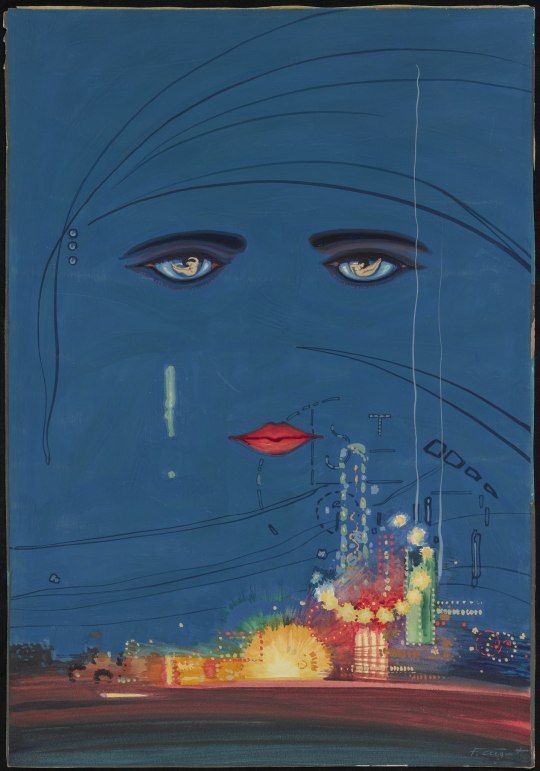#Francis Cugat
Photo

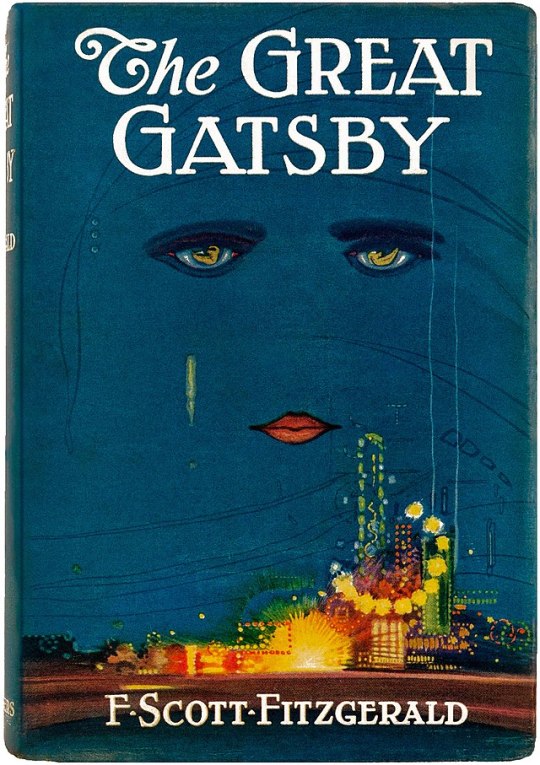
Did you know that the original cover of the American novel The Great Gatsby was made by a Catalan artist?
His name was Francis Cugat (an anglicized version of his birth name Francesc Cugat), and he was brother to the famous musician Xavier Cugat. Francesc was born in 1893 in Barcelona (Catalonia), but when he was young his family migrated to Cuba and later to the USA.
He was a little-known illustrator who worked creating posters for American opera houses when he was found by F. Scott-Fitzgerald’s publisher while the author was still working on the book. The publisher sent Francis Cugat a summary of the novel and the working title “Among Ash Heaps and Millionaires”, and commissioned him to make a book cover. Francis Cugat made various sketches around the idea of a disembodied face of a flapper suspended over the New York cityscape. He sent this final version to the publisher, and both him and Fitzgerald loved it.
Fitzgerald was still working on the manuscript when he received the illustration. As his letters to the editor show, he was so pleased with the image that he intentionally edited his writing to tie it into the book. The letters don’t clearly state what parts of the book were influenced by the cover, but it's believed that the face at the cover inspired the description of the billboard of optometrist T. J. Eckleburg, and also a description of Daisy as the “girl whose disembodied face floated along the dark cornices and blinding signs”.
For the rest of his life, Francis Cugat continued painting and making illustrations for films and theatre, and later became a Technicolor colour consultant for more than 60 Hollywood films and as a set designer. He died in 1981. His work is little known, but his Celestial Eyes remain one of the most famous book covers of all times.
#francis cugat#arts#pintura#art#the great gatsby#artist#book cover#literature#books#blue#illustration#american literature#francis coradal#francis coradal-cugat#bookblr#1920s
364 notes
·
View notes
Photo
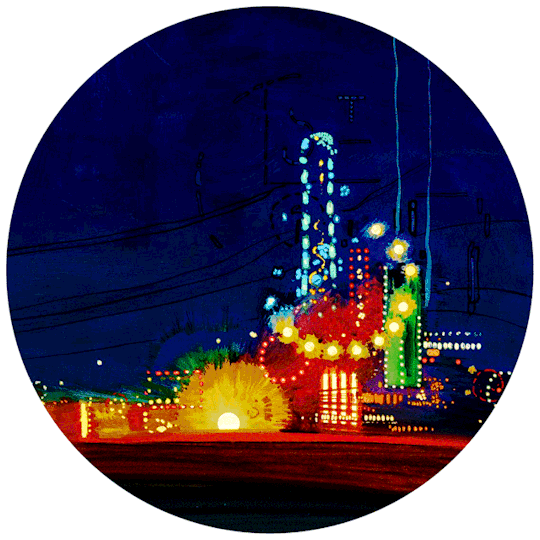
After Cugat: Lights (Animation from Celestial Eyes by Francis Cugat) - digital media - robert matejcek - 2022
“The lights grow brighter as the earth lurches away from the sun and now the orchestra is playing yellow cocktail music and the opera of voices pitches a key higher."
- The Great Gatsby - F. Scott Fitzgerald
Tags:
#robert matejcek#digital media#francis cugat#celestial eyes#1924#detail#the great gatsby#dust jacket#book cover#literature#f scott fitzgerald#cityscape#neon#lights#nocturanal#architecture#americana#just for fun#the jazz age#1920s#art deco#art
16 notes
·
View notes
Photo
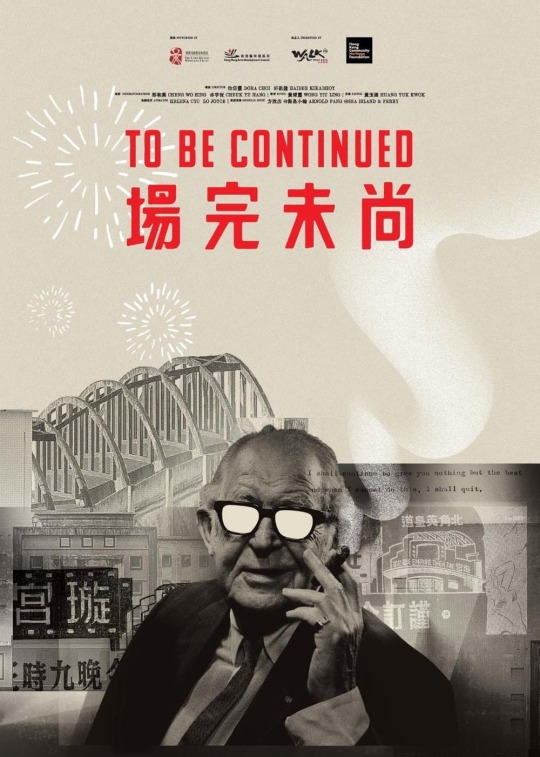
The Story Of The 1st Impresario In Hong Kong Mr Harry Odell, His Empire Theatre (璇宮戲院) & To Be Continued尚未完場, The Touching Film About This Jewish Man
An ‘impresario’ is a person who organizes and finances concerts, plays and operas. Art intermediaries are important. They make the availability of art performances much more accessible for the public. A good impresario knows well the audience and their needs.
Mr Harry Odell, a Jewish man, was born in 1896. He came to live in Hong Kong in 1921 and died in 1975 at the age of 79.
It was said that his real name was ‘Harry Obadofsky’. He was the son of Russian Jewish parents. He was educated at St. Francis Xavier’s College, in Shanghai. He ran away from home at 16 and supported himself as a tap dancer in Japan, before emigrating to the USA. In 1921, Obadofsky arrived in Hong Kong and changed his surname to Odell for the reason of marrying a girl Sophie Weill whose family owned the prestigious jewellery business Sennet Freres in Hong Kong. He fought in the defence of Hong Kong in 1941 and was made a prisoner of war by the Japanese.
Mr Odell loved art and culture. By persuading international acclaimed artists such as Xavier Cugat and Issace Stern to perform here in the colony in those years, he was the first impresario in the history of Hong Kong. He tirelessly lobbied the colonial government to build a permanent place for art performances. As a result, the first such venue, Hong Kong City Hall, was completed in 1962(information provided by Judy Green from 'The Dictionary of Hong Kong Biography’).
Mr Odell built his own concert theatre and film cinema known as the ‘Empire Theatre璇宮戲院’ in 1952. It was located in the North Point area along King’s Road and in those years, North Point was regarded as a remote place. Business was bad and it closed in 1957, and re-opened in 1959 as the ‘State Theatre皇都戲院’ following the purchase by a rich Chinese businessman and extensive renovations. The State Theatre sadly closed in 1997.
Concerns were raised in 2015 that the heritage building might be demolished. In 2020, a big property developer in Hong Kong New World Development acquired the ownership right of the Theatre and put forward good proposals related to the conservation of State Theatre. The Theatre is being repaired and will be opened soon for the third time.
The above is not just a story of history. It is a love story of how Harry Odell loved Hong Kong and how we loved this art hero. His life is one big touching story with hundreds of little touching stories within it.
2 film directors, Dora Choi & Haider Kikabhoy, made an evocative documentary movie about the noble story of Harry Odell and it is called To Be Continued 尚未完場. This piece of impressive work looks back on the history of the State Theatre (formerly the Empire Theatre) and the great life of Harry Odell. A film critic wrote this: “Kikabhoy and Choi created a film that is not just educational; it is also upbeat, amusing and heart felt at the same time.”
Apart from visiting Odell’s grave in Happy Valley and gazing at Odell’s former residence Old Alberose in Pokfulam, you must watch this heart-warming good film To Be Continued!
Maurice Lee
To Be Continued Trailer https://youtu.be/U6GICy7Nmpc Acknowledgement – 尚未完場
Hong Kong City Hall https://youtu.be/fg97X8gfsrA Acknowledgement – Online Museum
State Theatre https://youtu.be/S7D0U8DgEyo Acknowledgement – Bloomberg Television
#Sophie Weill#Sennet Freres#Xavier Cugat#Issace Stern#Judy Green#Dora Choi#Haider Kikabhoy#Old Alberose#St. Francis Xavier's College#New World Development#Hong Kong City Hall#State Theatre皇都戲院#The Dictionary of Hong Kong Biography
0 notes
Text
“don’t judge a book by its cover” Wrong. Absolutely judge a book by its cover art.
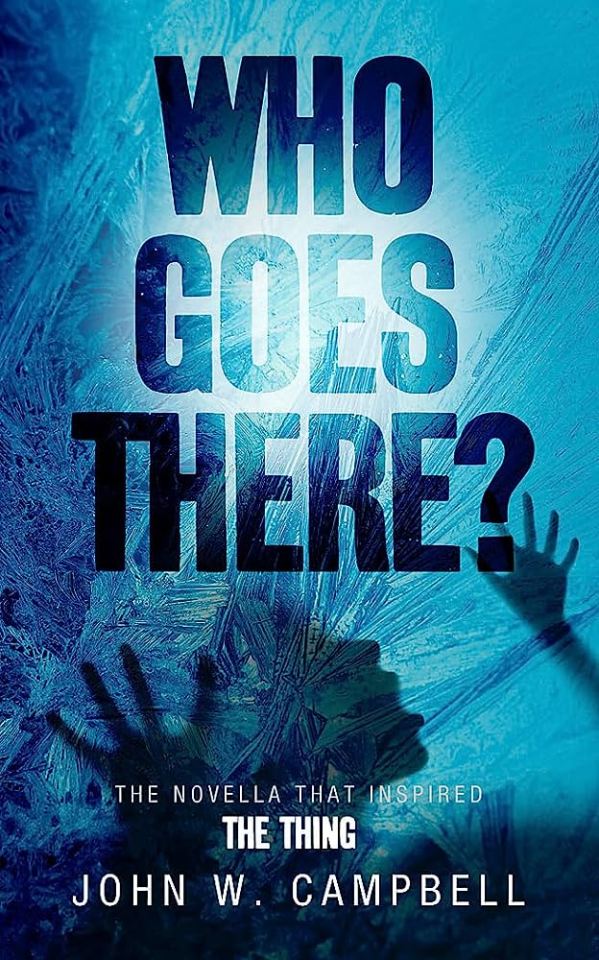
Take a look at this cover of a repress of “Who Goes There?” by John W. Campbell. A decent cover, yes? You’d see this on the shelf, think it looks okay, and then never think about it again.
Now look at THIS.
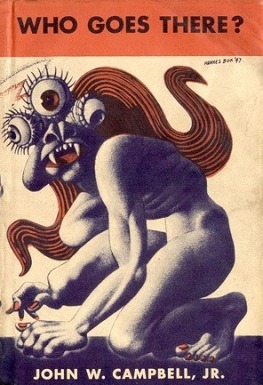
The first pressing cover of the novel from 1948 by illustrator Hannes Bok. Look at how fucking hard it goes. Look how it combines surrealist, almost gothic imagery with the main themes of the novel (humanity, paranoia, etc.). Look at the fucking FACE. Instantly more memorable and will definitely leave an impact on whichever library-goer sees it first.
To some, first impressions are extremely important when it comes to a piece of text or media. If you can judge an album or a game by its art, then surely you can judge a book by one.
SEE ALSO:
The Great Gatsby, with its amazing first press cover, painted by Francis Cugat

A Clockwork Orange has many great ones, but the one copy I have has a boring Penguin template one
#book covers#books#maybe i’m wrong#this is just an excuse to ramble about who goes there’s first cover#fucking love the goofy guy on the front#gecko boy#who goes there?#john w. campbell#the great gatsby#a clockwork orange
330 notes
·
View notes
Text

Here you go, anon: 42 signs for the price of 14! Turns out I was a lazy monster and had mostly popped my own textures into the original packages (available here, if you want more contemporary/English language advertising), so I fixed that and cleaned up some little texture issues in the process. When I was taking preview pics I remembered how annoying it was that only the big six-tile mesh was quarter-tile enabled. I fixed the smaller 3- and 4-tile meshes; nothing is renamed so let these overwrite any you might have in your downloads already.

Row 1: Hanby Auto Sales, Simoco 1, Simoco 2, Texaco
Row 2: Sofi Pofi soap, Great Gatsby-inspired eyes, Rinso laundry soap, Mr. Crack in Simlish
Row 3: Cerise Noir cigarettes, Lucky Strike cigarettes, Llama brand cigarettes
Row 4: Bostonian/Bruenig Shoes, Downtown deco clip art, asbestos
DOWNLOAD recolors + fixed meshes
(or just the two meshes, if you want)
As usual, do what you want with them, slap 'em on a new mesh or whatever, have a blast. Credits: Raynuss (for meshes & some recolors I turned Simlish), @franzillasims & @ajaysims & @chere-indolente for Simlish fonts, Francis Cugat, psycho/pinksoim for Sofi Pofi as a soap brand, and asbestos (Don't allow a CHEAPER and INFLAMMABLE product to puncture your desire with hesitation, it says. Which is real ad copy.)
Because I originally did this for myself, I didn't keep very detailed image credits. That makes me feel a bit bad, but that's the nature of ephemera like this. A few were recent simlifications from James Lileks' archived 1922 printing trade mag.
110 notes
·
View notes
Text
Nadando contra la marea —
Crítica de Polar Blues (Azules polares), Antonio Leyva
Desireé Estrella

Polar Blues, Antonio Leyva - marzo de 2014-Medio: Acrílico en hoja de lona - 50x40cm
La transición turbulenta de un niño forzado a dar un salto a la adultez, antes de estar preparado. Pero, ¿alguna vez se está completamente preparado? Y si los días sólo tienen rayos efímeros de sol, ¿en dónde se busca el calor? Antonio Leyva reflexiona estas preguntas y presenta las emociones fluctuantes de su adolescencia en esta obra, mientras que a los demás nos toca buscar nuestro reflejo en ella.
“Every rise is a day.”, dice Antonio. Toda colina es un día.
Antonio trabajó en esta pintura varias madrugadas durante dos semanas, entre los meses de febrero y marzo de 2014; entre la preparación de su ingreso universitario, el aprendizaje de vivir solo a los 16 (con su familia en otro país) y las inquietudes cotidianas de la vida y la juventud. Mientras mantenía un exterior orgulloso y firme, su única manera de liberar estas emociones era a través del arte. Polar Blues representa, entonces, los días que comenzaban en la oscuridad del negro azabache, y los sentimientos oscilantes de azul, blanco y gris que se fundían en la duración del día.
El cuadro empezó como una gráfica a lapiz en la parte inferior; los picos negros indicaban lo oscuro que empezaban sus días (16 días en total), lo difícil que sería levantarse esa mañana y cómo esa oscuridad podría seguirle a lo largo del día. El azul del cuadro, su percepción de esos días, en los que recordaba cómo se sentía, pero que acababan desdibujándose en un océano de monotonía con pequeños destellos blancos o de azul claro de algo distinto a esa nebulosa sensación.
Entra al agua y encuéntrate a ti mismo, en estas oleadas de azul que empujan contra el negro profundo, rastros de toda persona. Detrás de las olas, vemos no sólo las luchas comunes de un niño hecho hombre forzadamente, sino la separación entre un niño y su familia, vemos una batalla contra la depresión, una lucha por mantener una apariencia falsa, la cual podría desmoronarse en cualquier momento. Durante este tiempo, Antonio dudaría una y otra vez de haber tomado la decisión correcta al mudarse al extranjero a una edad tan temprana, al alejarse tanto de lo que más conocía.
¿Estamos todos trabajando hacia la nada? ¿Estamos todos nadando contra la marea como Sísifo haciendo rodar esa piedra colina arriba?
Si lo somos, la pregunta sería: ¿qué hemos hecho para merecer este castigo? ¿Cuándo dejará de parecer un castigo?
"¿Todos los demás tienen estas preguntas, o soy sólo yo?" No hay forma de saberlo con certeza.
Inspirado en el expresionismo abstracto que se encuentra dentro de las obras de Mark Rothko, aprendiendo de su uso del color e influenciado por el protagonismo de los colores en la portada original de El Gran Gatsby (edición de 1925), realizada por Francis Cugat (Ojos Celestes, 1924), libro que estudiaba durante esos largos días, Antonio aprovechó la oportunidad de explorar su mente, permitiéndose el tiempo para meditar con sus emociones y sentimientos, buscando sus direcciones.
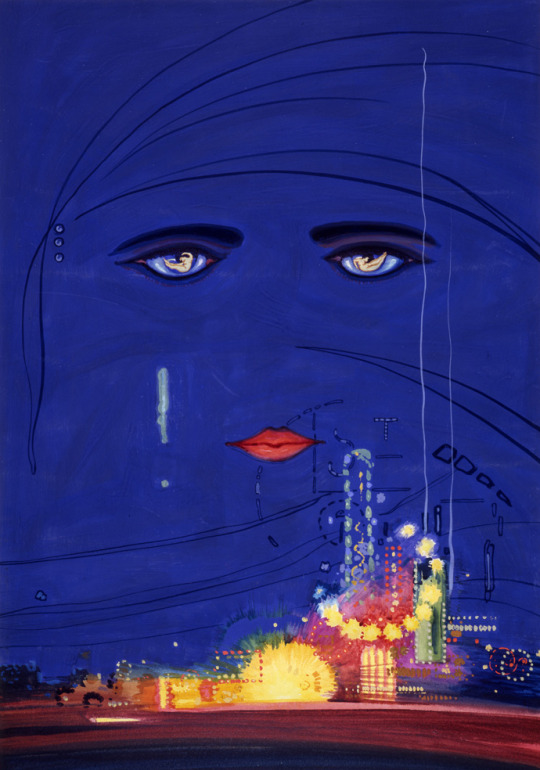
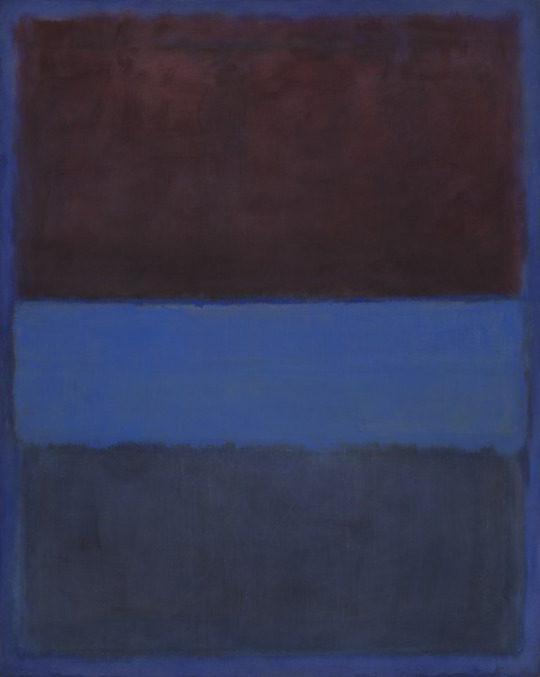
Permítete meditar tú también, dejando que las olas te bañen, te recuerden lo que sientes y se lleven con ellas los oscuros acantilados.
2 notes
·
View notes
Text

Celestial Eyes, Francis Cugat, Gouache Painting, 1924
3 notes
·
View notes
Text
Greatest Hits of 1950 | Top Music Hits 1950 | Songs of 1950 [1950s Hits]
Greatest Hits of 1950 | Top Music Hits 1950 | Songs of 1950 [1950s Hits]
00:00 Introduction 00:12 English 05:41 French 06:32 German 07:32 Italian 08:32 Portuguese 09:26 Spanish Greatest Hits of 1950 including: Anton Karas - The Third Man, Billy Eckstine - My Foolish Heart, Bing Crosby - Dear Hearts and Gentle People, Bing Crosby - Rudolph The Red-Nosed Reindeer, Doris Day – Bewitched, Eileen Barton - If I Knew You Were Coming (I'd've Baked a Cake), Ernie Ford & Kay Starr - I'll Never Be Free, Eve Young - Silver Dollar, Frankie Laine - The Cry of the Wild Goose and many more! Subscribe to our channel to see more of our content! Related Searches: Greatest Hits of 1950, Best Jukebox 1950 Playlist, Late 1950 Non Stop , Top 1950 Non Stop, Mix 1950 Compilation, Best 1950 List, Late 1950 UK, Best 1950 Playlist, Best 1950 Non Stop, Best 1950 Video, Greatest 1950 Non Stop, Mix 1950 Playlist, Best Jukebox 1950 List, List of 1950 Mix, Top 1950 USA, Best Songs of 1950, Top Music 1950, Hits of 1950 Related Channels: K-Music, Ultra Lists, Younger days, Music Hits, DJ Crayfish, Redlist, Music Express, Some Random Guy, Francis Pelletier, MarioMex International Mixes, Top Culture, Related Videos: https://www.youtube.com/watch?v=R1zM5WF1NF0 https://www.youtube.com/watch?v=5qmoZ9W8kQg 1. Anton Karas - The Third Man 2. Billy Eckstine - My Foolish Heart 3. Bing Crosby - Dear Hearts and Gentle People 4. Bing Crosby - Rudolph The Red-Nosed Reindeer 5. Doris Day - Bewitched 6. Eileen Barton - If I Knew You Were Coming (I'd've Baked a Cake) 7. Ernie Ford & Kay Starr - I'll Never Be Free 8. Eve Young - Silver Dollar 9. Frankie Laine - The Cry of the Wild Goose 10. Gary Crosby & Bing Crosby - Play A Simple Melody 11. Gary Crosby & Bing Crosby - Sam's Song 12. Gordon Jenkins & His Orchestra - Bewitched 13. Gordon Jenkins & His Orchestra - My Foolish Heart 14. Guy Lombardo - The Third Man 15. Hardrock Gunter - Birmingham Bounce 16. Kay Starr - Bonaparte's Retreat 17. Nat King Cole - Mona Lisa 18. Patti Page - All My Love 19. Patti Page - Tennessee Waltz 20. Perry Como - Hoop-Dee-Doo 21. Phil Harris - The Thing 22. Piano Red - Rockin' With Red 23. Red Foley - Chattanooga Shoe Shine Boy 24. Sammy Kaye - Harbor Lights 25. Sammy Kaye & Don Cornell - It Isn't Fair 26. Steve Conway - My Foolish Heart 27. Teresa Brewer - Music Music Music 28. The Ames Brothers - Can Anyone Explain (No, No, No!) 29. The Ames Brothers - Rag Mop 30. The Ames Brothers - Sentimental Me 31. The Andrews Sisters - I can dream, can't I? 32. The Andrews Sisters - I wanna be loved 33. The Cap-Tans - I'm So Crazy For Love 34. The Weavers and Gordon Jenkins - Goodnight, Irene 35. The Weavers and Gordon Jenkins - Tzena Tzena Tzena 36. Tony Martin - There's No Tomorrow 37. Wynonie Harris - Rock Mr. Blues 38. André Claveau - Cerisier rose et pommier blanc 39. Charles Trenet - Douce France 40. Edith Piaf - Hymne à l'amour 41. Éliane Embrun - Mam'zelle Dimanche 42. Félix Leclerc - Le p'tit bonheur 43. Pierre Malar - Je t'aimerai 44. Anneliese Rothenberger & Detlev Lais - La Le Lu 45. Hans Albers - Nimm mich mit, Kapitän, auf die Reise 46. Rene Carol - Buona Notte, Angelo Mio 47. Rita Paul - Das ist nichts für kleine Mädchen 48. Rudi Schuricke - Florentinische Nächte 49. Vico Torriani - Santa Lucia 50. Carla Boni - Il mago Baku 51. Giorgio Consolini - Forse domani 52. Nilla Pizzi - Che bel fiulin 53. Roberto Murolo - Me so' 'mbriacato 'e sole 54. Sergio Bruni - Surriento d'e 'nnammurate 55. Tito Schipa - Anema E Core 56. Carmélia Alves - Trepa no Coqueiro 57. Dalva de Oliveira - Olhos Verdes 58. Deolinda Rodrigues - Fado da saudade 59. Isaura Garcia & Hervê Cordovil - Pé de manacá 60. Ismael Silva - Antonico 61. Luiz Gonzaga - Assum Preto 62. Celia Gámez - Estudiantina Portuguesa 63. Elvira Ríos - Frenesí y Perfidia 64. Jorge Negrete - México Lindo y Querido 65. Juanito Valderrama - El emigrante 66. Pérez Prado & His Orchestra - Mambo No. 5 67. Xavier Cugat & His Orchestra - Tico Tico Relate Hashtags: #listof1950mix #hits1950 #bestsongs1950 #classic1950playlist #greatest1950nonstop #best1950list #best1950video #top1950mix #greatest1950video #mix1950playlist #top1950nonstop #mix1950compilation
https://www.youtube.com/watch?v=lU-5LIaU500
#80S Greatest Hits#Songs Of 1980S#Old Songs#80S Songs#80S Music Hits#80S Hits#80S Songs Playlist#Grea
2 notes
·
View notes
Photo

“They were careless people, Tom and Daisy- they smashed up things and creatures and then retreated back into their money or their vast carelessness or whatever it was that kept them together, and let other people clean up the mess they had made.” ― The Great Gatsby (1925) Art for the 1st cover of The Great Gatsby by Francis Cugat. https://www.instagram.com/p/CerL2upsSuZ/?igshid=NGJjMDIxMWI=
0 notes
Text
#ArtfulThrawn "Celestial Chiss Eyes"
#ArtfulThrawn “Celestial Chiss Eyes”
“Celestial Eyes” is the first cover of F. Scott Fitzgerald’s “The Great Gatsby” in 1925 features the artwork of Francis Cugat.
References
Source 1Source 2

View On WordPress
3 notes
·
View notes
Photo

Ninety-five years ago today, April 10, 1925, Scribner’s published F. Scott Fitzgerald’s third novel. “The Great Gatsby” was the final choice for a title, beating out “Trimalchio in West Egg,” “Gold-Hatted Gatsby,” and “Under the Red White and Blue.”
The illustrator, Francis Cugat, created the design while Fitzgerald was writing the book. The author was so struck by the imagery that he worked it into the novel, and he wrote to Charles Scribner III, "For Christ's sake, don’t give anyone that jacket you’re saving for me. I’ve written it into the book."
Today, the original book jacket draws more at auction than a first edition of the novel itself.
57 notes
·
View notes
Text

THE GREAT GATSBY by F. Scott Fitzgerald (New York: Scribner, 1925). Cover art by Francis Cugat.
Set on the prosperous Long Island of 1922, the novel provides a critical social history of Prohibition-era America during the Jazz Age. Fitzgerald's fictional narrative fully renders that era’s jazz music, economic prosperity, flapper culture, libertine mores, rebellious youth, and speakeasies.

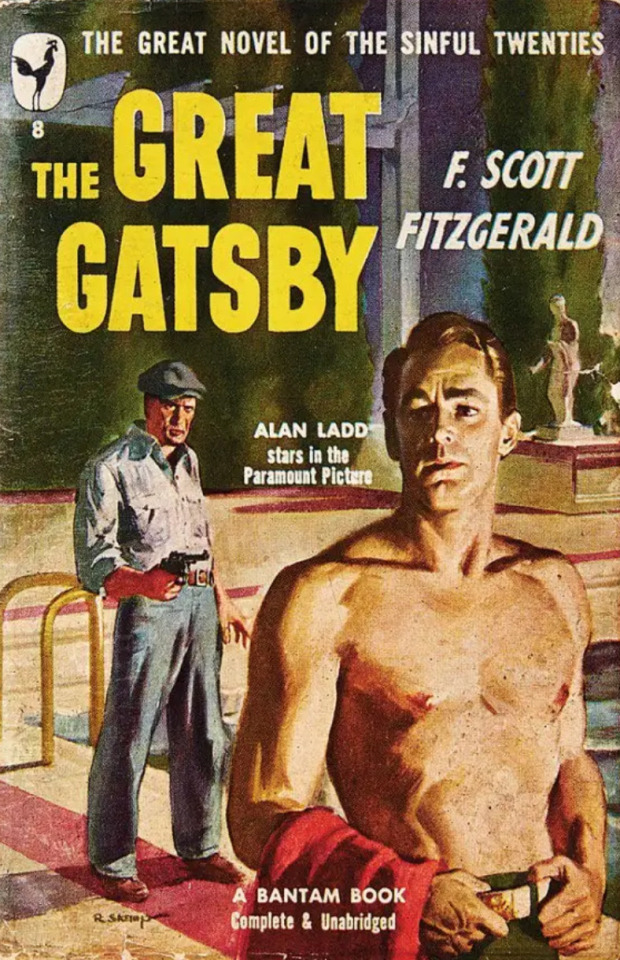

F. Scott Fitzgerald (1896-1940) was best known for depicting the flamboyance and excess of the Jazz Age. During his lifetime, he published four novels, four story collections, and 164 short stories. He also worked as a Hollywood screenplay writer. Although he achieved some success in the 1920s, Fitzgerald believed himself to be a failed writer. He became widely known after his death due in part to the Armed Services editions of his books distributed during the Second War War. Translated into 42 languages, THE GREAT GATSBY is now widely regarded as a “Great American Novel”.
#books#book cover#book blog#banned books#books books books#bookaholic#f. scott fitzgerald#the great gatsby#jazz age#daisy buchanan#jay gatsby#hedonism#prohibition era#flapper
8 notes
·
View notes
Text
ROUGH ROAD TO TOP
August 16, 1953
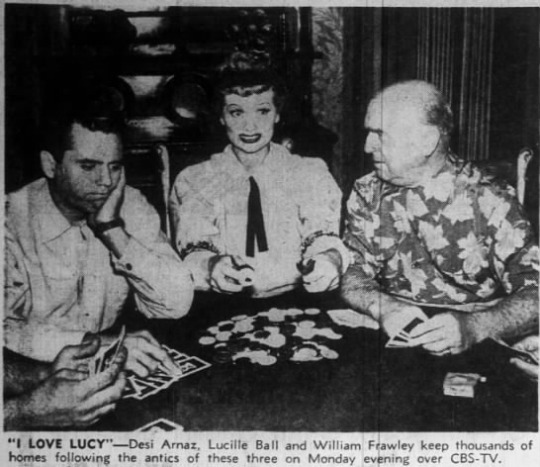
(1)

One of the more famous CBS-TV shows is “I Love Lucy.”
Its two chief characters - Lucille Ball and Desi Arnaz - have had a rocky road to their present status as one of the top comedy teams in the country.
At the end of Lucille's first year in dramatic school she was told by her teachers that she was wasting her time and money, that she would never become an actress. She was fired from all four of her first jobs as a chorus girl. Later, as a model, she almost lost her life in an automobile accident and was told she would never walk again.
Revolution Factor
It was a revolution in Cuba and a mishap in World War II which were fateful turns in Arnaz’ trip to stardom. The Cuban revolution destroyed his family’s wealth, drove them to the United States. World War II got him a broken kneecap in basic training, and since he had been a professional entertainer, he was placed in limited service and assigned to entertain hospitalized G.I.s'.
Columbia Pictures gave Lucille a contract as a stock player, and, convinced that her luck finally had turned, she sent for mother, grandfather, and sister to join her in California. But, the morning after she wired her family, the studio decided to dissolve its stock company. When the family arrived, Lucille was working as an extra at Paramount.
Bit parts and extra roles in a number of pictures kept Lucille busy, but not prosperous, until she was cast in ’"Roberta.” RKO officials, impressed by her work, gave her a contract. When not busy before the cameras, she was a mainstay of the studio's Little Theater. (2)
Offered Stage Lead
Her performance in the second lead in “The Girl from Paris" (3) drew Broadway's attention to Miss Ball and she was offered a lead in the musical "Hey Diddle Diddle.” After satisfying her yen to perform on the Great White Way (4), she returned to Hollywood for "Stage Door” and “Too Many Girls.” In the latter picture, she was costarred with Desi Arnaz. They were married Nov. 30 1940 in Greenwich, Conn.
Back from her honeymoon, Lucille walked into her first really big break a role in "The Big Street,” based on a story by Damon Runyon (5). Overnight it made her a star.
Her first assignment at M.G.M. in 1942 was the title role in the Technicolor production "Du Barry Was a Lady” (6). Stellar roles followed in "Best Foot Forward” and "Meet the People" (7). After completing "Easy to Wed” with Van Johnson (8), she headed for New York to be with her husband, then out of the army and on his way to success in the orchestra business.
Starred on Tour
Shortly after completing "Her Husband’s Affairs,” (9) Miss Ball went on tour as star of Elmer Rice's play "Dream Girl” (10) then worked with Sonny Tufts and Victor Mature in "Interference” for R.K.O. (11)
Lucille, Desi, arid their year-old daughter Lucy Desiree, live at Desilu, their five-acre ranch at Chatsworth, Calif. They raise cattle, chickens, dogs, and cats and dabble in farming. Enthusiastic fishermen they spend a lot of time on their boat.
Desiderio Alberto Arnaz y de Acha was born in Santiago, Cuba, son of the mayor. Desi’s mother, Dolores de Acha, was considered among the 10 most beautiful women In Latin America.
Three ranches totaling 100,000 acres, a palatial home in the city, a private island in Santiago Bay, speedboats, a fleet of motor cars, and a racing stable were all at the command of the youthful Desi during the pre-revolutionary days. His father, after eight years as mayor of Santiago, was made a member of the Cuban congress In 1932.
On Aug. 12, 1933, came the revolution. Congress was dissolved. Its members jailed. The Arnaz property was confiscated, the homes burned to the ground. In 24 hours everything was gone except $500 Desi's mother had hidden. Desi and mother fled to Miami, devoted the next six months to efforts to free Papa Arnaz. from prison. They were finally reunited in Florida.
For Desi, life in these United States for several years was hard but interesting: he worked at truck driving, train yard checking, taxi driving, bookkeeping, and, of all things, bird cage cleaning. Desi’s father managed to launch an importing business. It went broke when a shipment of fruit spoiled in transit.
Show business at this point finally caught up with Desi. His first job was playing guitar and singing with a seven-piece rhumba band at Miami’s Roney-Plaza Hotel (12). Xavier Cugat (13) spotted him, was impressed with this Cuban boy who was to be dubbed "The Tempo” by critics of modem music. After a year as featured vocalist with the Cugat band, Desi organized his own group of musicians and moved into the swank La Conga Café in Miami (14).
George Abbott's Broadway hit "Too Many Girls” (15) was Desi’s next step up the ladder, in 1939. He played a Cuban football player, one of the leads, and played tropical drums. RKO bought the film rights and signed Desi to play his stage role. When the shooting was over Desi married the leading lady, Lucille Ball.
He spent from Feb. 1943 to Nov. 1945 in the Army, after which he toured the nation with his band playing theaters, dances, night clubs. He hasn’t been without a band since. In 1948, Desi made the Columbia film "Holiday in Havana.” (16)
He made a vaudeville tour with Lucille Ball and that convinced them they’d do well as a husband-and-wife team on television. The tour inspired the CBS-TV show “I Love Lucy,” which has been highly rated since it started. (17)
Desi Arnaz’s personality is as vibrant as the music he makes. He is friendly, direct in manner, has flashing dark brown eyes and brown hair. He’s an avid fisherman, rides and swims expertly: his tennis is the envy of his San Fernando Valley neighbors, Sue and Alan Ladd, Francis Lederer, Jackie Oakie, and the Andrews Sisters. (18) A good cook, he specializes in such tempting dishes as Ginger Beef and Bouillabaisse.
# # #
FOOTNOTES FROM THE FUTURE

(1) The photo is from “Be a Pal” (ILL S1;E2) aired on October 22, 1951, nearly two years earlier. There’s one thing missing from this file photo: Vivian Vance. The success of the show was its foursome, not threesome! If you look closely you can see the hands of the other poker players, Richard Reeves (Hank, left) and Tony Michaels (Charlie, right).
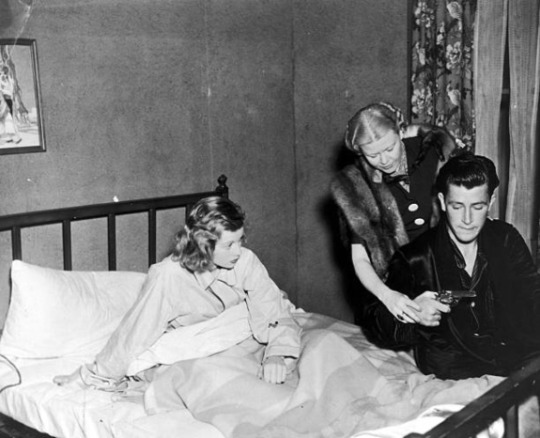
(2) Lucille did several plays at the RKO Little Theatre under the direction of Lela Rogers (above), Ginger’s mom. When Lucille later bought RKO, she dubbed it the Desilu Playhouse, a training ground for new young performers, often hand selected by Ball herself.
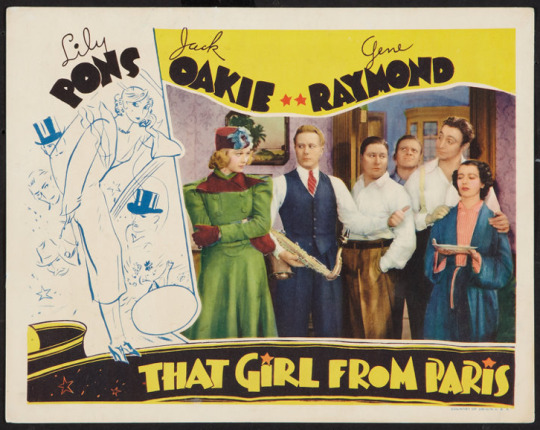
(3) “That Girl from Paris” (not “The” as the article states) was Lucille’s 33rd film. The light-hearted musical romance earned an Oscar nomination for Sound Recording. It was released on the first day of 1937.
(4) Lucille was indeed cast in the Broadway-bound comedy (it was not a musical, however) “Hey Diddle Diddle!” It opened in Princeton, New Jersey, the first of several out-of-town stops on the way to Broadway. What Lucille’s publicity omits is that the show never got further than Washington DC due to the serious illness of its leading man, Conway Tearle. So Lucy’s Broadway debut would have to wait - until 1960!
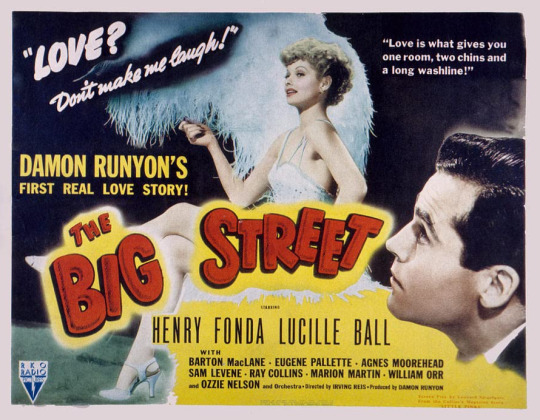
(5) “The Big Street” opened on September 4, 1942. It was based on a Damon Runyan short story about a night club singer (Lucille) embittered by an accident that left her in a wheelchair and her romance with a naïve admirer (Henry Fonda) named Pinks. Lucy later said it was her favorite of the many films she made. It was her 55th film.
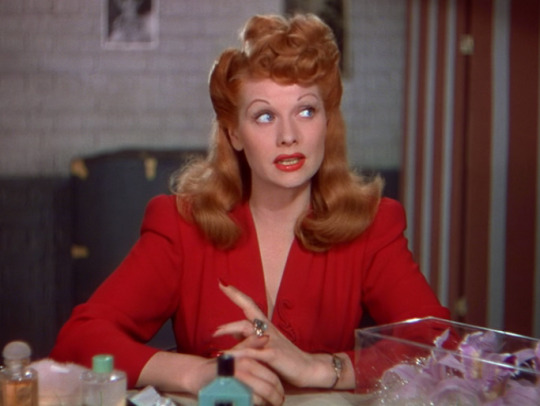
(6) “Du Barry Was A Lady” premiered in August 1943. It was Lucille’s 57th film, but her first for MGM. She nabbed the role from her friend Ethel Merman, who had done the Cole Porter musical comedy on Broadway. It was filmed in color, and was the film that earned her the nickname “Technicolor Tessie” because of her bright orange hair - a color she committed to from then on, despite her roots! This is the film that introduced Lucy to the song “Friendship”, which she would also sing on “I Love Lucy.”
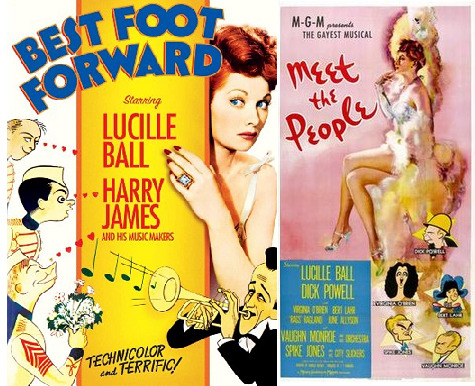
(7) In the musical comedy “Best Foot Forward” (1943) Lucille Ball played herself. It was her 58th film. “Meet The People” (1944) was a romantic comedy for MGM, Ball’s 60th film.
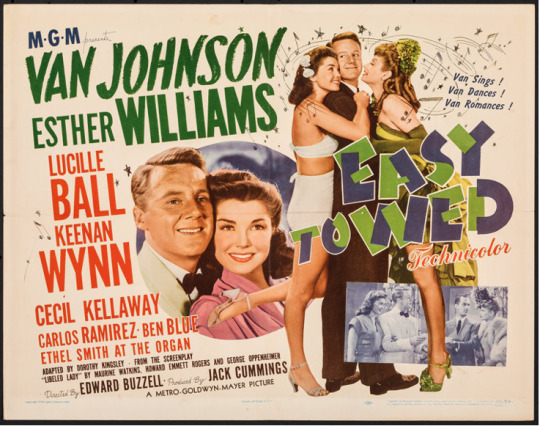
(8) In 1946 she released her 63rd film, “Easy To Wed” co-starring Van Johnson and Esther Williams. Lucille and Van had appeared together in “Too Many Girls” and he would appear on Lucy’s television shows.
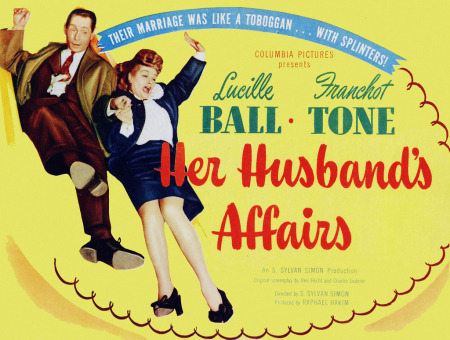
(9) “Her Husband’s Affairs” (1947) was a romantic farce with Lucy teamed with Franchot Tone. It was her 69th film.

(10) Back to the stage, Lucille accepted the leading role in a revival tour of “Dream Girl” a fantasy comedy by Elmer Rice. Once again, the play launched in Princeton, but this time Broadway was not the goal. It had already played the Great White Way two years earlier. The play toured the country at select cities, landing Lucille back in California in late 1947. In one SoCal gig she was appearing simultaneously with Desi and his band just a few blocks away. No doubt this was by design.

(11) RKO’s “Interference” was re-named “Easy Living” (1949) and dealt with the world of professional sports, namely football. It co-starred Victor Mature and Sonny Tufts. It was Ball’s 71st film.

(12) The luxurious Roney Plaza Hotel in Miami Beach was located on the corner of Collins Avenue and 23rd Street. It opened in 1925 and was demolished in 1968. The resort attracted a who's who that included Hollywood stars and even the Duke and Duchess of Windsor. The hotel's Bamboo Room & Restaurant was the place to be seen on the Beach for decades.
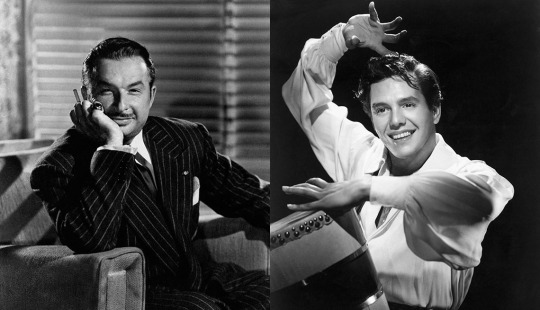
(13) Xaviar Cugat (1900-1990) was a Spanish musician and bandleader who spent his formative years in Havana, Cuba. A trained violinist and arranger, he was a leading figure in the spread of Latin music. In New York City he was the leader of the resident orchestra at the Waldorf–Astoria before and after World War II. He was a mentor and friend to Desi Arnaz, who kept his name before the public by making him a rival of Ricky Ricardo on “I Love Lucy” where his name became a punchline. In reality, Desi was grateful to Cugat, not jealous of him!
“I learned a lot from Xavier Cugat” ~ Desi Arnaz

(14) La Conga Café was located in New York City, not Miami, although the article may be referring to a different, lesser known establishment where Desi Arnaz performed. He became a regular headliner at La Conga, even issuing a record titled “La Conga” in 1939.

(15) Speaking of 1939 New York, Desi appeared in his only Broadway show in 1939, Rogers and Hart’s “Too Many Girls.” When the film rights were purchased by RKO, Desi was hired by director George Abbott to recreate his role. It was while filming this movie that he met Lucille Ball.

(16) “Holiday in Havana” was a Columbia picture released in October 1949. The film is about a Cuban hotel busboy (Arnaz) who dreams of becoming a composer. His love interest was not Lucy, but Mary Hatcher.

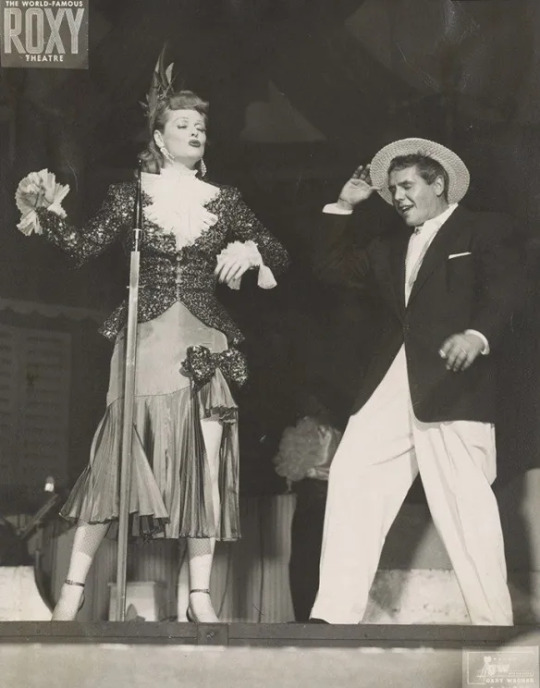
(17) The Tour incorporated some of the same routines seen in the “I Love Lucy” pilot as well as early episodes of the series, most notably the “Cuban Pete / Sally Sweet” duet. The tour culminated at the Roxy in New York City, where Desi was playing when he married Lucille in 1940.

(18) Before moving to their Beverly Hills mansion, Lucy and Desi lived on a ranch in Chatsworth in San Fernando Valley. They dubbed their ranch home Desilu. About their neighbors:
Alan Ladd (1913-64) was a chorus boy when Lucille was an Earl Carroll showgirl in Murder at the Vanities (1934). He was married to Sue Carol (1906-82) from 1942 until his death. Carol’s name was mentioned on “I Love Lucy” in “The Fashion Show” when Lucy selects the same Don Loper original that Carol has chosen to wear in the fashion show. She does not appear on screen.
Francis Lederer (1899-2000) was a Hungarian-born actor. In 1960 he did an episode of Desilu’s “The Untouchables”. From 1941 until his death he was married to Marion Irvine.
Jackie Oakie (1903-78) did four films with Lucille Ball between 1934 and 1938, including both “Annabell” movies.
The Andrews Sisters were the pre-eliminant close-harmony girl group of their time. The consisted of Patty, Maxine, and LaVerne. They were mentioned on “I Love Lucy” in “Be a Pal” in the same scene that the photo at the top of the article came from. In 1969, Patty Andrews guest-starred as herself on “Here’s Lucy”. Lucy and Lucie played the other two Andrews sisters.
13 notes
·
View notes
Text
next is 60s jazz
n the late 1960s, Latin jazz, combining rhythms from African and Latin American countries, often played on instruments such as conga, timbale, güiro, and claves, with jazz and classical harmonies played on typical jazz instruments (piano, double bass, etc.) broke through. There are two main varieties: Afro-Cuban jazz was played in the US right after the bebop period, while Brazilian jazz became more popular in the 1960s. Afro-Cuban jazz began as a movement in the mid-1950s as bebop musicians such as Dizzy Gillespie and Billy Taylor started Afro-Cuban bands influenced by such Cuban and Puerto Rican musicians as Xavier Cugat, Tito Puente, and Arturo Sandoval. Brazilian jazz such as bossa nova is derived from samba, with influences from jazz and other 20th-century classical and popular music styles. Bossa is generally moderately paced, with melodies sung in Portuguese or English. The style was pioneered by Brazilians João Gilberto and Antônio Carlos Jobim. The related term jazz-samba describes an adaptation of bossa nova compositions to the jazz idiom by American performers such as Stan Getz and Charlie Byrd.Bossa nova was made popular by Elizete Cardoso's recording of Chega de Saudade on the Canção do Amor Demais LP, composed by Vinícius de Moraes (lyrics) and Antonio Carlos Jobim (music). The initial releases by Gilberto and the 1959 film Black Orpheus brought significant popularity in Brazil and elsewhere in Latin America, which spread to North America via visiting American jazz musicians. The resulting recordings by Charlie Byrd and Stan Getz cemented its popularity and led to a worldwide boom with 1963's Getz/Gilberto, numerous recordings by famous jazz performers such as Ella Fitzgerald (Ella Abraça Jobim) and Frank Sinatra (Francis Albert Sinatra & Antônio Carlos Jobim), and the entrenchment of the bossa nova style as a lasting influence in world music for several decades and even up to the present.this is from a article in wiki
2 notes
·
View notes
